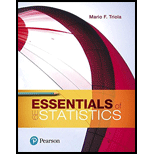
Concept explainers
Testing Claims About Proportions. In Exercises 9–32, test the given claim. Identify the null hypothesis, alternative hypothesis, test statistic, P-value, or critical value(s), then state the conclusion about the null hypothesis, as well as the final conclusion that addresses the original claim. Use the P-value method unless your instructor specifies otherwise. Use the
15. Survey Return Rate In a study of cell phone use and brain hemispheric dominance, an Internet survey was e-mailed to 5000 subjects randomly selected from an online group involved with ears. 717 surveys were returned. Use a 0.01 significance level to test the claim that the return rate is less than 15%.
Trending nowThis is a popular solution!
Learn your wayIncludes step-by-step video

Chapter 8 Solutions
Essentials of Statistics (6th Edition)
Additional Math Textbook Solutions
Introductory Statistics (2nd Edition)
Statistics: The Art and Science of Learning from Data (4th Edition)
Intro Stats, Books a la Carte Edition (5th Edition)
An Introduction to Mathematical Statistics and Its Applications (6th Edition)
Statistics for Business and Economics (13th Edition)
- Constructing Normal Quantile Plots. In Exercises 17–20, use the given data values to identify the corresponding z scores that are used for a normal quantile plot, then identify the coordinates of each point in the normal quantile plot. Construct the normal quantile plot, then determine whether the data appear to be from a population with a normal distribution. Female Arm Circumferences A sample of arm circumferences (cm) of females from Data Set 1 “Body Data” in Appendix B: 40.7, 44.3, 34.2, 32.5, 38.5.arrow_forwardLarge Data Sets from Appendix B. In Exercises 25–28, use the data set from Appendix B to test the given claim. Use the P-value method unless your instructor specifies otherwise. Diastolic Blood Pressure for Men Repeat the preceding exercise for adult males instead of adult females.arrow_forwardQUESTION: Investigate and explain about t- distribution and then provide 2 examples and solve it by using the table.arrow_forward
- Complete the table below and find the variance and standard deviation of the ff. probability distribution. (Answer should be in yellow pad.) V. ASSESSMENT 1. x•P(x) X2•P(x) P(x) 3/10 10 2/10 2/10 2/10 4 25arrow_forwardConstructing Frequency Distributions. In Exercises 11–18, use the indicated data to construct the frequency distribution. (The data for Exercises 13–16 can be downloaded at TriolaStats.com.) Old Faithful Listed below are sorted duration times (seconds) of eruptions of the Old Faithful geyser in Yellowstone National Park. Use these times to construct a frequency distribution. Use a class width of 25 seconds and begin with a lower class limit of 125 seconds.arrow_forwardExample (H.W.): Find the mean and variance from the m. g. f.of binomial distribution.arrow_forward
- Example (H.W.): Find the mean and variance from the m. g. f. of binomial distribution.arrow_forwardFinal Conclusions. In Exercises 25–28, use a significance level of α = 0.05 and use the given information for the following: a. State a conclusion about the null hypothesis. (Reject H0 or fail to reject H0) b. Without using technical terms or symbols, state a final conclusion that addresses the original claim. Original claim: The standard deviation of pulse rates of adult males is more than 11 bpm. The hypothesis test results in a p-value of 0.3045.arrow_forward6 Joan records the temperature every day. The highest temperature she recorded was 29 °C to the nearest degree. Let X represent the error in the measured temperature. a Suggest a suitable model for the distribution of X. b Using your model, calculate the probability that the error will be less than 0.2°C. e Find the variance of the error in the measured temperature.arrow_forward
- Eagles always lay three eggs at a time. The number of eggs that hatch is described by the following probability distribution: 1. P(X = x) 0.1 0.3 0.4 0.2 Find the mean, variance and standard deviation. Write your solution on your paper. 3.arrow_forwardMATH STATISTICS Part 4. 1. Examine the data set below that represents a sample. F.) the first, second and third quartiles; G.) the interquartile interval; H.) the standard deviation of the sample; I.) The variance of the sample.arrow_forwardIV. Exercises: Find the Mean, variance and the standard deviation of the following probability distribution. x p(x) x.p(x) P(x) 0.238 2 0.290 0.177 0.158 0.137 Find: p= ? o2 = ? O = ? 34arrow_forward
 Glencoe Algebra 1, Student Edition, 9780079039897...AlgebraISBN:9780079039897Author:CarterPublisher:McGraw Hill
Glencoe Algebra 1, Student Edition, 9780079039897...AlgebraISBN:9780079039897Author:CarterPublisher:McGraw Hill
